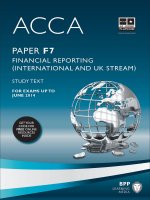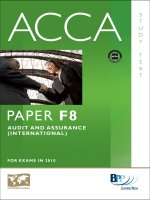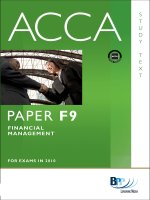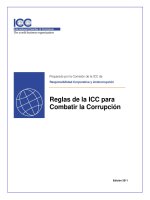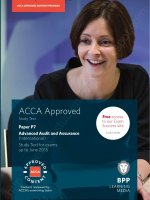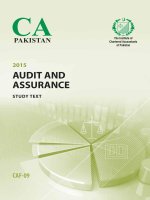FAR january 2019 study text overview general purpose financial statements
Bạn đang xem bản rút gọn của tài liệu. Xem và tải ngay bản đầy đủ của tài liệu tại đây (66.81 KB, 5 trang )
General—Purpose Financial Statements
Overview—General Purpose Financial Statements
After studying this lesson, you should be able to:
1. Describe the form and content of the Income Statement.
2. Describe the form and content of the Balance Sheet.
3. Describe the form and content of the Statement of Cash Flows.
I.
Summary of the Primary Financial Statements—Here we present an overall summary of the basic
financial statements. Later lessons will cover each statement in more depth.
A. Income Statement—Statement of Profit or Loss
1.
The income statement measures the performance of the firm for the period. It is dated for the
entire period (e.g., for the year ended December 31, 20xX).
2.
The income statement is prepared by applying the all-inclusive approach. That is, almost all
revenues, expenses, gains, and losses are shown on the income statement and are included in
the calculation of net income. A major exception here is prior period adjustments, which are the
effects of corrections of errors affecting prior year net income. Prior period adjustments are
shown on the Statement of Retained Earnings as adjustments to the beginning balance of
retained earnings in the year the error is discovered.
3.
There are other items that would appear to be income items but are not reflected in net income.
These include unrealized gains and losses on investments in securities available-for-sale, certain
pension cost adjustments, and foreign currency translation adjustments. These items are
included in comprehensive income, which now is a required disclosure. However, except for
items included in comprehensive income but not also in net income, prior period adjustments,
and a few other items, the reporting of net income in the income statement reflects an
all-inclusive approach.
B. Statement of Comprehensive Income
1.
The statement of comprehensive income reports all non-owner changes in equity over a period
of time—the same time period as the income statement. This statement is also dated for the
year ended December 31, 20xX.
2.
The statement of comprehensive income includes net income (or loss) and the items included
in comprehensive income that are not part of net income. Those items include:
a.
Unrealized gains and losses on available-for-sale securities
b. Adjustments in the calculation of the pension liability
c.
Foreign currency translation adjustments
d. Deferrals of certain gains or losses on hedge accounting.
C. Balance Sheet—Statement of Financial Position
1.
The balance sheet discloses the resources of the firm at a point in time. It is dated as of a specific
date (e.g., December 31, 20xX).
2.
The balance sheet is formally referred to as the Statement of Financial Position, but balance
sheet is the more commonly used term. A business enterprise discloses its economic resources
(assets) and the manner of financing the acquisition of those resources (creditors, owners’
contributions, and prior year’s earnings) in the balance sheet.
1
State and Local Governments
3.
Formats for presentation
a.
The presentation format for a balance sheet is typically one of two formats: the account
format or the report format.
b. In the account format, the assets are shown on the left side of the page, and the liabilities
and owners’ equity are shown on the right side. This format emphasizes the balance sheet
equation: A = L + OE.
Account Format
c.
Debits
Credits
Assets
Liabilities
Stockholders’ Equity
In the report format, which is the most popular form, the three categories of accounts are
listed from top to bottom, as in a report, with assets always shown first.
Report Format
Assets
Liabilities
Stockholders’ Equity
4. Classification of accounts
a.
Regardless of balance sheet format, assets, liabilities, and equities are presented on the
balance sheet in a prescribed order, which is summarized below.
i.
Assets are presented in order of decreasing liquidity. The most liquid assets (such as
cash) are shown first, and less liquid assets are shown last (such as property, plant, and
equipment).
ii. Liabilities are shown in order of maturity. Current liabilities are presented first and then
long-term liabilities are presented.
iii. Owners’ Equity (also referred to as Shareholders’, Stockholders’, or Shareowners’ Equity)
items are shown in order of permanence.
Example
For a corporation, the contributed capital accounts are shown first and retained earnings
are typically shown as the final item in Stockholders’ Equity. Retained earnings are thought
to be less permanent due to the fact that dividends are a distribution of earnings.
5.
Balance sheet presentation
a.
Balance sheet presentation reflects the classification of assets and liabilities. The
classification criteria used for each is indicated below and is affected by the firm’s operating
cycle. The operating cycle of a firm is the period of time required to purchase or produce
inventory, sell the inventory, and collect cash from the resulting receivables. For most firms,
the operating cycle is significantly less than one year. For firms in some industries, such as
construction, the operating cycle is longer than one year.
2
Overview—General Purpose Financial Statements
b. Current assets—Assets that are in the form of cash, or will be converted into cash, or
consumed within one year or the operating cycle of the business, whichever is longer.
Example
Cash, accounts receivable, short-term investments, inventory, and prepaid assets are
current assets.
c.
Current liabilities—Liabilities that are due in the upcoming year or in the operating cycle
of the business, whichever is longer, and that will be met through the transfer of a current
asset or the creation of another current liability. Both criteria must be met in order for a
liability to be classified as current.
Example
Accounts payable, wages payable, income tax payable, unearned revenues, and warranty
liability are current liabilities. (For the last two items, only the portion to be extinguished
within one year of the balance sheet would be classified as current.) Also, the current
portion of long-term debt is classified as current; it is the amount of debt previously
classified as long-term that is now due within one year of the balance sheet date.
d. Long-term assets and long-term liabilities—These are defined by exclusion. All assets
that do not meet the criteria necessary to be classified as current are classified as long-term
assets. Likewise, all liabilities that do not meet the criteria necessary to be classified as
current are classified as long-term liabilities.
Example
Long-term investments, plant assets, certain deferred charges, and intangible assets are
non-current assets. Notes and bonds payable and mortgages payable are long-term
liabilities.
6. Valuation and measurement
Note
CPA Exam questions tend to emphasize sections of the balance sheet. For example, a question might
focus on the property, plant, and equipment section of the balance sheet or on the long-term liability
section of the balance sheet. As we cover the individual items presented on the balance sheet, these
problems will be a primary focus.
a.
Balance Sheet Valuation is summarized below but will be emphasized more in the coverage
of individual balance sheet items. The point here is that the meaning of the dollar amount
of an item listed in the balance sheet depends on the account being measured.
b. Several different measurement bases are currently used in the balance sheet. For example,
an account receivable listed at $10,000 does not necessarily mean the same thing as $10,000
listed for an intangible asset.
3
State and Local Governments
Account Type
Measurement Basis
Property, Plant and Equipment, Intangibles
Receivables
Inventory
Historical Cost and Depreciated/Amortized
Historical Cost
Net Realizable Value
Lower of Cost or Market
Investments in Marketable Securities
Liabilities
Market Value
Present Value
Owners’ Equity
Historical Value of Cash Inflows and Residual
Valuation
D. Statement of Stockholders’ Equity—The statement of stockholders’ equity (sometimes referred to
as shareholders’ equity) presents the changes in the owners’ equity over a period of time—the same
time period as the income statement. Like the income statement, this statement is dates for the year
ended (e.g., December 31, 20xX). This statement presents the changes in contributed capital,
additional paid-in capital, and retained earnings. These changes arise from the purchase and sale of
shares of the entities stock, the changes in comprehensive income, and the payment of dividends.
E.
Statement of Cash Flows
1.
The statement of cash flows is the third of the three major financial statements required to be
reported. It describes the major changes in cash by meaningful category. Like the income
statement, it is dated for the entire period (e.g., for the year ended December 31, 20xX).
2.
The purpose of the Statement of Cash Flows is to explain the change in cash and cash
equivalents that has occurred during the past accounting year. Cash equivalents are short-term
investments that:
a.
Are convertible into a known and fixed amount of cash; and
b. Have an original maturity to the purchaser of three months or less.
Example
A US treasury obligation purchased when there are three months or less remaining to
maturity is a cash equivalent. Investments in stocks are not cash equivalents because they
have no maturity value and are not convertible into a specific unchanging amount of cash.
3.
In reviewing the statement of cash flows, it is important to remember the articulation between
the balance sheet and the statement of cash flows. If the statement of cash flows employs a
pure cash definition of funds, the first asset listed on the balance sheet will be cash. If the
statement of cash flows employs a broader definition of funds (cash and cash equivalents), the
first asset listed on the balance sheet will be Cash and Cash Equivalents.
4. The presentation of cash flows in the statement of cash flows follows a classification system
established by the FASB. Cash flows are classified into three categories: operating, investing,
and financing.
a.
Operating—Those cash flows related to transactions that flow through the income
statement.
Example
Operating cash inflows include receipts from customers and interest. Cash outflows
include payments to suppliers, to employers, and to taxing authorities.
4
Overview—General Purpose Financial Statements
b. Investing—Cash flows related to the acquisition and disposal of long-term assets and
investments (other than cash equivalents and trading securities; these are operating).
Example
Investing cash outflows include purchases of plant assets and investments. Cash inflows
include proceeds from the sale of these items.
c.
Financing—Cash flows related to the liabilities and owners’ equity sections of the balance
sheet.
Example
Financing cash inflows include issuing debt and equity securities. Cash outflows include
retirement of debt and equity securities, and dividend payments.
5

